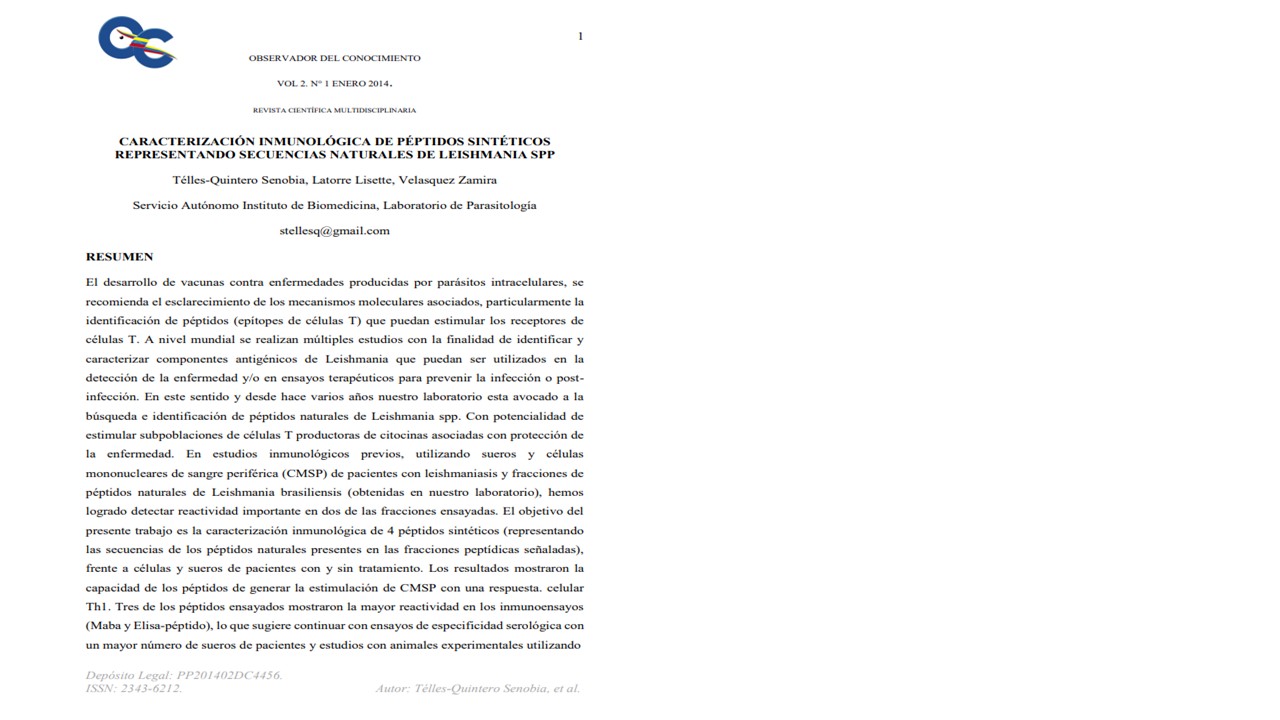Immunological Characterization of Synthetic Peptides Representing Natural Sequences of Leishmania SPP
Keywords:
Chronological characterization, peptide, Leishmania SppAbstract
In the development of vaccines against diseases caused by intracellular parasites, the elucidation of the associated molecular mechanisms is recommended, particularly the identification of peptides (T cell epitopes) that can stimulate T cell receptors. Multiple studies are carried out worldwide with the purpose of identifying and characterizing antigenic components of Leishmania that can be used in the detection of the disease and/or in therapeutic trials to prevent infection or post-infection. In this sense and for several years our laboratory has been dedicated to the search and identification of natural peptides from Leishmania spp. With the potential to stimulate subpopulations of cytokine-producing T cells associated with protection from the disease.
Downloads
References
Babaloo, Z.; Kaye, P.M.; Eslami, M.B. (2001). Interleukin-13 in Iranian patients with visceral leishmaniasis: relationship to other Th2 and Th1 cytoquines. Trans R Soc Trop Med Hyg. 95:85-88.
Bourreau, E.; Prevot, G.; Pradinaud R. et al. 2001. Interleukin (IL)-13 is the predominant Th2 cytokine in localized cutaneous leishmaniasis lesions and renders specific CD4+ T cells unresponsive to IL-12. J Infect Dis 183:953-59.
Campos-Neto, A.; Soong, L.; Cordova, J.L.; Sant’Angelo, D.; Skeiky, Y.A.; Ruddle, N.H.; Reed, S.G.; Janeway, C. Jr.; McMahon-Pratt, D. (1995).
Cloning and expression of a Leishmania donovani gene instructed by a peptide isolated from major histocompatibility complex class II molecules of infected macrophages. J. Exp. Med. 82(5):1423-1433.
Demontz SA, Grey E, Apella EY, et al. 1989. Characterization of a naturally processed. Leishmania major using peripheral blood mononuclear cells from Leishmania- naive humans. Am J Trop Med Hyg 71: 568-576.
Histocompatibility Complex Class II Molecules of Infected Macrophages. J Exp Med. 182: 1423-1433
Green SJ, Meltzer MS, Hibbs JB, et al. 1990. Activated macrophages destroy intracellular Leishmania major amastigotes by an L-arginine-dependent killing mechanism. Immunol 144: 278-282.
Leishmania donovani Gene Instructed by a Peptide Isolated from Major MHC class IIrestricted T cell determinant of hen egg lysozyme. Nature 342: 682-684.
Liscano María Gabriela, Zahira Longa, Mariangela Infante, Senobia Telles. 2011. Evaluación de un método para el aislamiento de péptidos naturales de Leishmania spp. Salus Abril 15: 1, 41-53
Malik P. Strominger JL. 2000. Perfusion chromatography for very rapid purification of class I and II MHC proteins. J Immunol Meth 234: 83-88.
Mosmann T.R. Cherwinsky H. Bond M.W. et al. 1986. Two types of murine helper T cell clone. I. Definition according to 154 profiles of lymphokine activities and secreted proteins. J Inmunol 136:2348-57.
McSorley S. Proudfoot L. O’Donnell C.A. et al. 1996. Immunology of murine leishmaniasis. Clin Dermatol 14:451-64.
Nashed B.F. Maekawa Y. Takashima M. et al. 2000. Different cytokines are required for induction and maintenance of the Th2 type response in DBA/2 mice resistant to infection with Leishmania major. Microbes Infect 2:1435-43.
Rogers KA, Titus, RG. 2004. Characterization of the early Cellular Immune response to.
Rudensky A, Janeway Jr C. 1993. Studies on naturally processed peptides associated with MHC class molecules. Chem Immunol 57: 134-151.
Scott P. 1991. Host and parasite factors regulation the development of CD4+ subsets in experimental cutaneous Leishmaniasis. Research in Immunology 42: 32-36.
Rötzschke, O., Falk, K. 1994. Origen, structure and motifs of naturally processed MHC class II ligands. Curr Opin Immunol 6: 45 - 51.
WHO Report on Global Surveillance of Epidemic-prone Infectious Diseases. 2010.
WHO/CDS/CSR/ISR/2000.1

Downloads
Published
How to Cite
Issue
Section
License

This work is licensed under a Creative Commons Attribution-NoDerivatives 4.0 International License.







